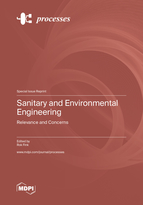Sanitary and Environmental Engineering: Relevance and Concerns
A special issue of Processes (ISSN 2227-9717). This special issue belongs to the section "Environmental and Green Processes".
Deadline for manuscript submissions: closed (25 February 2023) | Viewed by 20011
Special Issue Editor
Special Issue Information
Dear Colleagues,
Major concerns regarding health and the environment are at the heart of the United Nations Educational, Scientific and Cultural Organization's Sustainable Development Goals. Now more than ever, humanity is called upon to take action to protect the environment and public health. The environment in which we live is the most vital factor for our health and well-being. Human activities have significant impacts on the atmosphere, lithosphere, hydrosphere, biosphere, and even outer space. Biological, chemical, and physical risk factors are part of our everyday lives, and scientific research continuously faces challenges to understand and mitigate these interactions to make life on Earth more sustainable. The sustainability of human societies and the biodiversity that supports them requires the responsible supervision of natural resources, including the development of technologies and regulations.
Contributions to this Special Issue should cover the latest advances and trends in the field of sanitary and environmental engineering. We welcome comprehensive contributions such as papers, communications, and review articles that highlight the broad scope of the topic.
Dr. Rok Fink
Guest Editor
Manuscript Submission Information
Manuscripts should be submitted online at www.mdpi.com by registering and logging in to this website. Once you are registered, click here to go to the submission form. Manuscripts can be submitted until the deadline. All submissions that pass pre-check are peer-reviewed. Accepted papers will be published continuously in the journal (as soon as accepted) and will be listed together on the special issue website. Research articles, review articles as well as short communications are invited. For planned papers, a title and short abstract (about 100 words) can be sent to the Editorial Office for announcement on this website.
Submitted manuscripts should not have been published previously, nor be under consideration for publication elsewhere (except conference proceedings papers). All manuscripts are thoroughly refereed through a single-blind peer-review process. A guide for authors and other relevant information for submission of manuscripts is available on the Instructions for Authors page. Processes is an international peer-reviewed open access monthly journal published by MDPI.
Please visit the Instructions for Authors page before submitting a manuscript. The Article Processing Charge (APC) for publication in this open access journal is 2400 CHF (Swiss Francs). Submitted papers should be well formatted and use good English. Authors may use MDPI's English editing service prior to publication or during author revisions.






